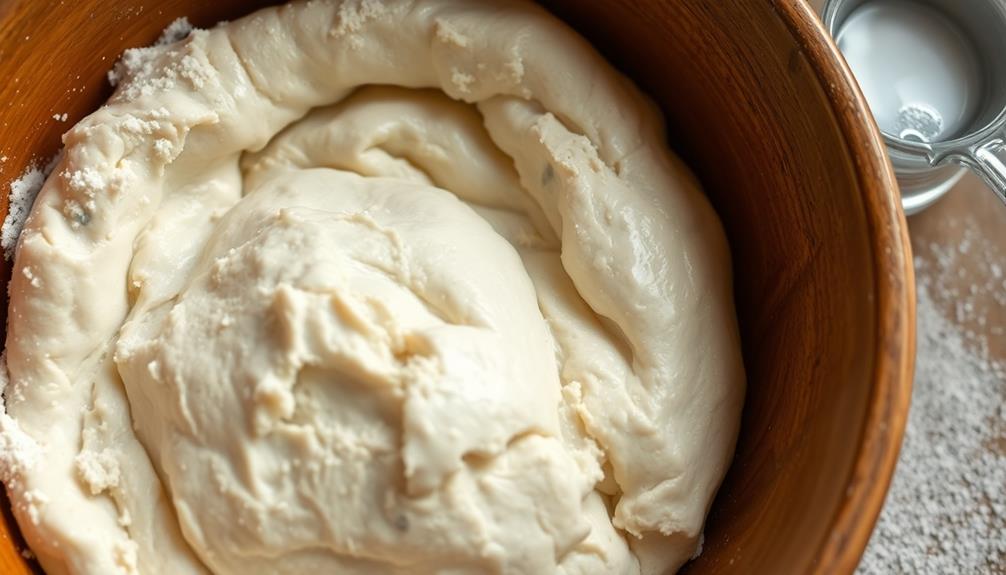To create the perfect pizza crust, you've got to understand the science of dough. Begin with flour, water, yeast, and salt; the proteins in the flour form gluten for structure. Aim for a hydration level of 65-70% for a lighter crust, or 55-60% for a chewier one. Stretch your dough gently to align those gluten proteins without tearing. Baking in the right oven—like a wood-fired or gas alternative—ensures even heat transfer, allowing for a crispy texture. Up your pizza game with innovative techniques and ingredient choices. Stick around to discover more secrets for that perfect slice!
Key Takeaways
- The ideal hydration level for pizza dough is between 65-70% for a lighter crust and 55-60% for a denser, chewier texture.
- Gluten formation from proteins in flour is essential for structure and chewiness, influencing overall crust quality.
- Yeast fermentation creates carbon dioxide, contributing to the dough's rise and enhancing flavor complexity.
- Proper stretching techniques align gluten proteins, ensuring the dough can hold toppings without tearing during baking.
- The type of oven used, such as wood-fired or gas, significantly affects crust texture and flavor through heat distribution.
The Chemistry of Pizza Dough

The Science Behind Perfect Pizza Crust
=========================
The Chemistry of Pizza Dough
—————————–
When you immerse yourself in the world of pizza dough, you'll discover it's a fascinating blend of science and culinary art. The chemistry of pizza dough revolves around its main ingredients: flour, water, yeast, and salt.
The proteins in the flour are essential for gluten formation, which provides the structure and that coveted chewy texture. As you mix the ingredients, the fermentation process kicks in. Yeast consumes sugars, producing carbon dioxide gas that makes the dough rise and enhances its flavor with ethanol.
This process is similar to how Yeduba Wat showcases rich gastronomic heritage through the use of simple yet effective ingredients.
Pay close attention to the hydration level, as it dramatically influences your dough's characteristics. A higher hydration level of 65-70% results in a lighter, airier crust, while 55-60% hydration creates a denser, chewier bite.
When you stretch the dough, gluten proteins align and elongate, much like polymers under tension, allowing your dough to hold toppings without tearing.
Hydration and Dough Behavior

Hydration plays an essential role in determining how your pizza dough behaves during mixing, rising, and baking. The water-to-flour ratio is vital; a higher hydration level (65-70%) produces a lighter, airier pizza crust with larger air pockets, similar to the lightness found in dishes like Grilled Peach and Burrata Salad.
Conversely, lower hydration dough (55-60%) yields a chewier crust, affecting the texture and mouthfeel of your pizza.
When working with wetter dough, you'll find that it requires less kneading and shorter baking times, helping you achieve that perfect crust more quickly. A drier dough, on the other hand, demands more kneading and longer cooking times to develop the desired characteristics.
Higher moisture levels boost steam production during baking, leading to a crisper exterior and better oven spring, enhancing the rise of your pizza.
Balancing hydration is essential; too much or too little can greatly impact the final texture and overall quality of your creation. By mastering the art of hydration, you can control the dough's behavior and elevate your pizza-making skills, ensuring every bite is a delightful experience.
Stretching and Heat Transfer

After mastering hydration, the next step in perfecting your pizza crust is stretching the dough effectively. Stretching not only shapes your pizza but also manipulates the gluten structure, enhancing its elasticity. To achieve the best results, consider these key tips:
- Always work with dough at room temperature for better stretchability.
- Apply gentle, even pressure to align gluten proteins. For instance, similar to how Red-Braised Pork Belly requires careful handling to achieve the perfect tenderness, your dough also benefits from patience in the stretching process.
- Avoid tearing by stretching gradually; let the dough relax if it resists.
- Keep an eye on the crust texture; it should be thin but sturdy.
- Understand how heat transfer affects the baking process.
During baking, heat transfer plays a significant role. In brick ovens, this occurs through conduction, where the hot oven floor directly cooks the crust, and convection, which circulates hot air for even cooking.
The thermal mass of the oven guarantees consistent heat distribution, essential for achieving that perfect crust texture and browning. By mastering both stretching techniques and understanding heat transfer, you'll be well on your way to creating an outstanding pizza that's sure to impress!
Types of Brick Ovens

There are several types of brick ovens, each offering unique benefits that can elevate your pizza-making experience.
Wood-fired ovens are a favorite for enthusiasts, reaching temperatures exceeding 800°F. This intense heat creates a quick cooking environment, yielding a perfectly crispy crust with a delightful smoky flavor. Additionally, the use of fresh ingredients in pizza can enhance the overall experience, similar to how Brazilian dishes like Caldeirada showcase the importance of quality components. To further elevate the pizza experience, understanding the science of cheese melting is crucial. The right combination of cheeses, such as mozzarella for stretch and fontina for flavor, can make all the difference in achieving that gooey, melty goodness we all love. When paired with the perfect dough and sauce, fresh ingredients and the science of cheese melting come together to create a truly exceptional pizza.
If you prefer consistent results, gas-fired ovens are your best bet. They provide reliable temperature control, guaranteeing even cooking and versatility across various pizza styles.
For those who want the best of both worlds, hybrid ovens combine the flavor enhancement of wood with the convenience of gas. This flexibility caters to diverse cooking needs while maintaining quality.
Electric ovens, while different, also excel in baking. Their heating elements, positioned above and below, guarantee even browning, making them suitable for home use with dependable results.
Regardless of the type you choose, the thermal mass of brick in these ovens retains heat effectively. This promotes even heat distribution, which is essential for enhancing crust development during baking.
Innovations in Pizza Making

Revolutionizing the art of pizza making, recent innovations are transforming how we create and enjoy this beloved dish.
You're now equipped with cutting-edge techniques that enhance every aspect of your pizza experience.
Here's what's new:
- Dough fermentation: Advanced technologies allow you to monitor yeast activity precisely, improving the flavors and textures of your crust. This meticulous process parallels the careful preparation of dishes like a Loaded Baked Potato, where the choice of ingredients greatly affects the final outcome.
- Hybrid ovens: These combine wood and gas-fired cooking, delivering high heat and unique flavors while ensuring consistent results.
- Flour blends: New options, including ancient grains and alternative proteins, open up a world of diverse textures and flavors for your crust.
- Heat transfer efficiency: Innovations in oven design enhance baking conditions, promoting superior crust development through improved insulation and airflow.
- Molecular gastronomy: This scientific approach introduces creative ingredient pairings and crust customization, allowing you to experiment like never before.
With these advancements, you're not just making pizza; you're crafting an experience that's as much about the art as it's about the science.
Immerse yourself in these innovations and elevate your next pizza night!
Frequently Asked Questions
What Is the Science Behind Pizza Dough Making?
When you knead dough, you're not just mixing ingredients; you're releasing a chain reaction. Yeast ferments, gluten develops, and hydration levels play an essential role, all combining to create that perfect pizza dough you crave.
What Is the Secret to a Crispy Pizza Crust?
To achieve a crispy pizza crust, you'll want to use high hydration dough, preheat your pizza stone, and incorporate oil. Docking the dough helps too, allowing steam to escape for an even texture.
What Is the Science Behind the Making of Pizza Bread That Makes It so Appetizing?
When you make pizza bread, the right balance of ingredients, fermentation, and baking techniques create an appetizing flavor and texture. You'll notice the delightful aroma, golden-brown color, and satisfying chewiness that draw everyone in.
What Makes Pizza Crust so Good?
You'll find pizza crust appealing because of its balance of chewiness and crispiness. The perfect combination of ingredients, hydration, and baking techniques creates that satisfying texture and flavor that keeps you coming back for more.
Conclusion
In the end, mastering the perfect pizza crust is like orchestrating a symphony—every ingredient plays an essential role. By understanding the chemistry of dough, hydration levels, and the art of stretching, you're set to elevate your pizza game. Whether you're using a traditional brick oven or experimenting with new techniques, the joy of creating that ideal crust is just a dough away. So roll up your sleeves, get creative, and savor every delicious bite!










